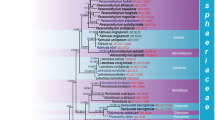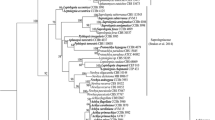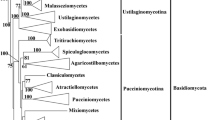Abstract
SSU rDNA was sequenced from the lichenized fungiBunodophoron scrobiculatum andLeifidium tenerum (Sphaerophoraceae), andStereocaulon ramulosum andPilophorus acicularis (Stereocaulaceae) and analysed by maximum parsimony with 44 homologous ascomycete sequences in a cladistic study. A small insertion (c. 60 nt.) was found in the sequence ofLeifidium tenerum. Sphaerophoraceae constitutes a strongly supported monophyletic group which groups together withLecanora dispersa and theStereocaulaceae. Together withPorpidia crustulata, this larger group is a sistergroup to thePeltigerineae. This analysis thus supports theLecanorales as monophyletic, includingSphaerophoraceae and thePeltigerineae, but does not provide strong support for this monophyly. The analysis also suggests that the prototunicate ascus in theSphaerophoraceae is a reversion to the plesiomorphic state. Based on morphological, anatomical and chemical reasons,Sphaerophoraceae is proposed to belong to one of the groups presently included in the paraphyletic suborderCladoniineae within theLecanorales.
Similar content being viewed by others
References
Bremer, K., 1988: The limits of amino acid sequence data in angiosperm phylogenetic reconstruction. — Evolution42: 795–803.
, 1994: Branch support and tree stability. — Cladistics10: 295–304.
Depriest, P. T., 1992: Molecular genetic analysis of ribosomal DNA polymorphism in theCladonia chlorophaea complex. — Dissertation, Duke University, USA.
Eriksson, O., 1981: The families of bitunicateAscomycetes. — Opera Bot.60: 1–220.
, 1995: Relationships of the generaNephroma, Peltigera andSolorina (Peltigerales, Ascomycota). — Syst. Ascomycetum14: 33–39.
Farris, J. S., 1995: The Parsimony Jackknifer, version 4.22. — Stockholm.
, 1996: Parsimony jackknifing outperforms neighbour-joining. — Cladistics12: 99–124.
Gargas, A., Depriest, P. T., 1996: A nomenclature for fungal PCR primers with examples from intron-containing SSU rDNA. — Mycologia88: 745–748.
-Taylor, J. W., 1992a: Molecular systematics of lichenized and non-lichenized fungi based on rDNA sequences. — InKårnefelt, I., (Ed.): IAL 2 Abstract volume: 9–10.
, 1992b: Polymerase chain reaction (PCR) primers for amplifying and sequencing nuclear 18S rDNA from lichenized fungi. — Mycologia84: 589–592.
, 1995: Phylogeny of discomycetes and early radiations of the apothecialAscomycotina inferred from SSU rDNA sequence data. — Exp. Mycol.19: 7–15.
, 1995a: Multiple origin of lichen symbiosis in fungi suggested by SSU rDNA phylogeny. — Science286: 1492–1495.
, 1995b: Positions of multiple insertions in SSU rDNA of lichen-forming fungi. — Molec. Biol. Evol.12: 208–218.
Grube, M., Gargas, A., Depriest, P. T., 1996: A small insertion in the SSU rDNA of the lichen fungusArthonia lapidicola is a degenerate group-I intron. — Curr. Genet.29: 582–586.
Hafellner, J., 1994: Problems inLecanorales systematics. — InHawksworth, D. L., (Ed.): Ascomycete systematics: problems and perspectives in the nineties, pp. 325–320. — New York, London: Plenum Press.
, 1994:Lecanorales. — InHawksworth, D. L., (Ed.): Ascomycete systematics: problems and perspectives in the nineties, pp. 379–387. — New York, London: Plenum Press.
Henssen, A., Jahns, H. M., 1973 (“1974”):Lichenes. Eine Einführung in die Flechtenkunde. — Stuttgart: Thieme.
Kållersjö, M., Farris, J. S., Kluge, G., Bult, C., 1992: Skewness and permutation. — Cladistics8: 275–287.
Lee, S. B., Milgroom, M. G., Taylor, J. W., 1988: A rapid, high yield mini-prep method for isolation of total genomic DNA from fungi. — Fungal Genet. Newslett.35: 23–24.
, 1990: Isolation of DNA from fungal mycelia and single spores. — InInnis, M. A., Gelfand, D. H., Sninsky, J. J., White, T. J., (Eds): PCR protocols: a guide to methods and applications, pp. 282–287. — London: Academic Press.
Mankin, A. S., Skryabin, K. G., Rubtsov, P. M., 1986: Identification of ten additional nucleotides in the primary structure of yeast 18S rRNA. — Gene44: 143.
Poelt, J., 1974 (“1973”): Classification. — InAhmadijan, V., Hale, M. E., (Eds): The lichens, pp. 599–632. — London: Academic Press.
Rambold, G., Triebel, D., 1992: The inter-lecanoralean associations. — Biblioth. Lichenol.48: 1–201.
Rubtsov, P. M., Musakhanov, M. M., Zakharyev, V. M., Krayev, A. S., Skryabin, K. G., Bayev, A. A., 1980: The structure of the yeast ribosomal RNA genes. I. The complete nucleotide sequence of 18S ribosomal RNA gene fromSaccharomyces cerevisiae. — Nucl. Acids Res.8: 5779–5794.
Swofford, D. L., 1993: PAUP: phylogenetic analysis using parsimony, version 3.1.1. — Washington: Smithsonian Institution.
Tehler, A., 1988: A cladistic outline of theEumycota. — Cladistics4: 227–277.
, 1990: A new approach to the phylogeny ofEuascomycetes with a cladistic outline ofArthoniales focussing onRoccellaceae. — Canad. J. Bot.68: 2458–2492.
Tibell, L., 1984: A reappraisal of the taxanomy ofCaliciales. — Beih. Nova Hedwigia79: 597–713.
Vobis, G., 1980: Bau und Entwicklung der Flechten-Pycnidien und ihrer Conidien. — Biblioth. Lichenol.14: 1–141.
Wang-yang, J.-R., Lai, M.-J., 1976: Notes on the lichen genusSphaerophorus Pers. of Taiwan, with description of three new species. — Taiwania21: 83–86.
Wedin, M., 1990: Ascocarp and spore ontogeny in two species ofSphaerophorus (Caliciales). — Nordic J. Bot.10: 539–545.
, 1993: A phylogenetic analysis of the lichen familySphaerophoraceae (Caliciales); a new generic classification and notes on character evolution. — Pl. Syst. Evol.187: 213–241.
, 1995: The lichen familySphaerophoraceae (Caliciales, Ascomycotina) in temperate areas of the Southern Hemisphere. — Symb. Bot. Upsal.31(1: 1–102.
White, T. J., Bruns, T., Lee, S., Taylor, J., 1990: Amplification and direct sequencing of fungal ribosomal RNA genes for phylogenetics. — InInnis, M. A., Gelfand, D. H., Sninsky, J. J., (Eds): PCR protocols: a guide to methods and applications, pp. 315–322. — London: Academic Press.
Author information
Authors and Affiliations
Rights and permissions
About this article
Cite this article
Wedin, M., Tehler, A. & Gargas, A. Phylogenetic relationships ofSphaerophoraceae (Ascomycetes) inferred from SSU rDNA sequences. Pl Syst Evol 209, 75–83 (1998). https://doi.org/10.1007/BF00991525
Received:
Revised:
Accepted:
Issue Date:
DOI: https://doi.org/10.1007/BF00991525




